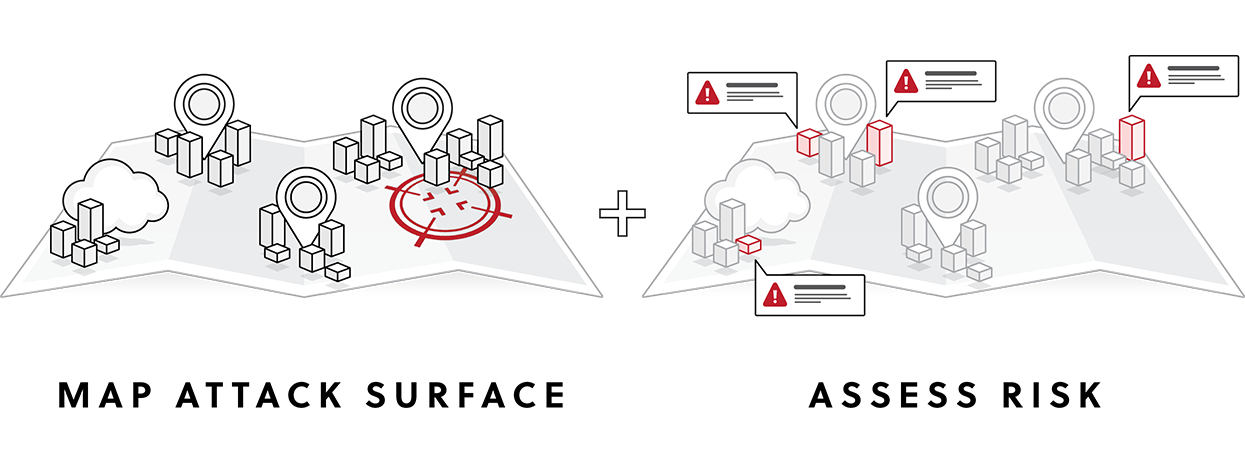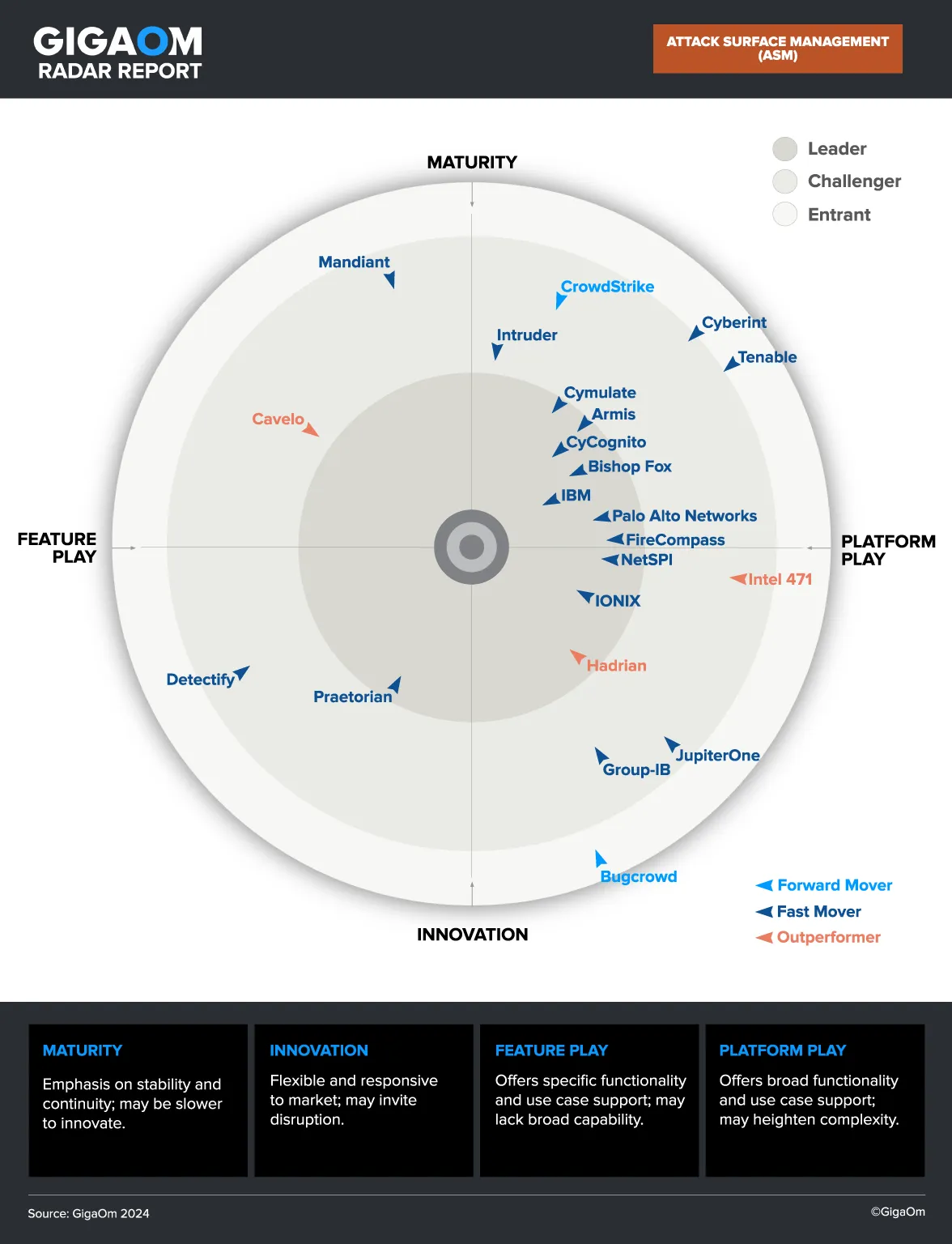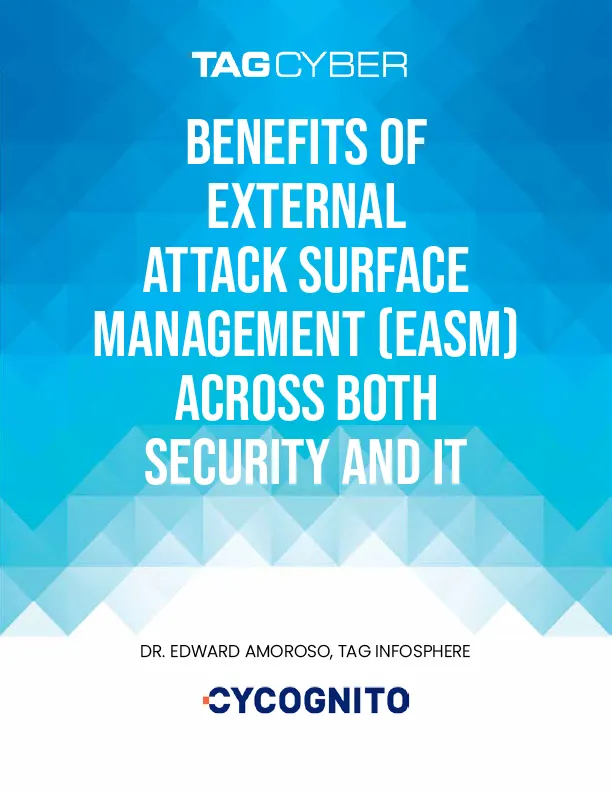What Is External Attack Surface Management (EASM)? 2025 Guide
6,866 views
External Attack Surface Management Defined
External attack surface management (EASM) refers to the process of identifying, analyzing, and mitigating the vulnerabilities and risks associated with an organization’s external-facing digital assets, such as websites, applications, network infrastructure and cloud environments. It involves monitoring and securing the exposed attack surface to prevent breaches and unauthorized access by threat actors.
While organizations often define “attack surface” too narrowly, attackers do not make that mistake. Attackers simply want access to your data, applications and networks whether on-premises or in cloud, subsidiary, third-party, or partner environments.
The best way to protect your organization's external attack surface, therefore, is to see, understand and manage all of the ways an attacker might get in.
Rise of the External Attack Surface
The external attack surface management has grown significantly as the digital footprint of organizations expands and evolves. In addition to traditional Internet-connected assets like servers and networks, this attack surface now covers a wide range of digital exposures such as cloud services, mobile apps, and IoT devices.
As businesses increasingly move their operations online and adopt cloud technologies, the boundaries of their external attack surfaces become more diffuse and challenging to secure. This expansion increases the number of potential entry points for attackers. Cybersecurity threats are a major driving factor for organizations to adopt External Attack Surface Management (EASM) as a way to mitigate these risks and protect their assets. Compounding this is the fact that organizations often focus on protecting the known attack surface. Many attacks originate from unknown or inadequately managed assets.
Organizations are rapidly deploying new technologies without necessarily having the security infrastructure in place to protect them. This rapid deployment can lead to misconfigurations and vulnerabilities that are easily exploitable by cybercriminals. Thus, the external attack surface is growing in both size and complexity.
How Does External Attack Surface Management Work?
External attack surface management works by continuously discovering and monitoring all internet-facing assets that belong to, or are associated with, an organization. This includes both known and unknown assets such as web servers, APIs, cloud services, domain names, IP addresses, third-party integrations, and even shadow IT.
The process typically starts with asset discovery, where tools use techniques like DNS enumeration, certificate transparency logs, and web crawling to identify all exposed assets. This is followed by asset classification to determine the business context and potential risk of each asset. Once assets are inventoried, EASM solutions perform vulnerability assessments and risk analysis to prioritize exposures based on severity and exploitability.

A key element is continuous monitoring. Since digital assets change frequently—due to deployments, acquisitions, or configuration changes—EASM tools automatically scan for new exposures and changes in asset posture. Alerts and reports are generated when risky changes are detected, enabling security teams to take corrective action.
EASM solutions also integrate with existing security tools like SIEMs and vulnerability management platforms to enrich visibility and enable coordinated response. Some platforms include threat intelligence feeds to correlate known malicious activity with an organization’s assets, further tightening defense.
Internal vs. External Attack Surface Management
Internal attack surface management focuses on the identification and mitigation of vulnerabilities within an organization's internal network perimeter and systems. It deals with securing assets and protecting against threats originating from within the organization's infrastructure. Examples include insider threats or malware introduced through internal systems.
External attack surface management focuses on the vulnerabilities present in an organization's externally-exposed assets. It involves monitoring and securing the digital footprint accessible to the public, including websites, servers, APIs, and cloud resources. The goal of EASM is to reduce risk from external threats, such as hackers, malicious actors, or automated bots attempting to exploit weaknesses in the external attack surface.
GigaOm Research Report
GigaOm Radar for Attack Surface Management
The expansion of an organization's attack surface continues to present a critical business challenge. Download the GigaOm Radar for Attack Surface Management to get an overview of the available ASM solutions, identify leading offerings, and evaluate the best solution for you.
What are the Main Challenges around External Attack Surface Mapping?
External attack surface mapping, or the process of identifying and mapping an organization's externally exposed assets, can pose several challenges:
- Complex, Distributed IT Environment: Organizations often have a vast and complex digital footprint, making it challenging to accurately identify all external-facing assets. This includes websites, subdomains, cloud instances, APIs, and third-party integrations. Mapping this extensive attack surface requires thorough discovery techniques and tools.
- Dynamic Nature of Assets: The digital landscape is continuously evolving, with assets being created, modified, or retired regularly. Keeping pace with these changes and maintaining an up-to-date map of the external attack surface requires ongoing monitoring and timely updates.
- Lack of Visibility: Organizations may lack comprehensive visibility into their external attack surface, especially if assets are spread across different departments, subsidiaries, or third-party providers. This lack of visibility makes it challenging to assess the overall security posture and identify exposed asset and potential vulnerabilities.
- Shadow IT: It is common for IT devices, software, and services to be deployed outside the ownership or control of IT departments. These can include unauthorized applications and cloud services that employees use for work purposes without approval. Shadow IT can significantly expand an organization’s external attack surface without its knowledge.
- Third-Party Risks: Organizations often rely on third-party vendors, suppliers, or partners for various services and integrations. However, these third parties can introduce vulnerabilities to the external attack surface. Mapping and assessing the security of these external entities pose challenges, as organizations may have limited control over their security practices.
- Evolving Threat Landscape: The threat landscape is constantly evolving, with new attack techniques, vulnerabilities, and threat actors emerging regularly. Keeping up with these evolving threats and ensuring that the external attack surface is adequately protected requires continuous monitoring, threat intelligence gathering, and proactive security measures.
The threat landscape is constantly evolving, with new attack techniques, vulnerabilities, and threat actors emerging regularly. Keeping up with these evolving threats and ensuring that the external attack surface is adequately protected requires continuous monitoring, threat intelligence gathering, and assessment of risk factors, through ongoing evaluation of identified risks.
Overcoming these challenges requires a combination of robust discovery techniques, automation, continuous monitoring, collaboration with third parties, and the allocation of appropriate resources to ensure comprehensive and effective external attack surface mapping.
6 Benefits of EASM Solutions
An external attack surface management (EASM) solution can be instrumental in addressing these challenges:
- Vulnerability Identification: EASM helps identify vulnerabilities and weaknesses in an organization's externally facing assets, including websites, servers, applications, and network infrastructure. By continuously scanning and monitoring externally-exposed assets, the solution can detect potential entry points for attackers and prioritize vulnerability remediation.
- Risk Reduction: EASM solutions helps reduce overall risk by proactively addressing vulnerabilities in the external attack surface. By mitigating weaknesses and strengthening security controls, organizations can minimize the chances of successful cyber attacks and data breaches.
- Compliance and Regulatory Alignment: EASM solutions assist organizations in meeting industry regulations and compliance requirements. By identifying and addressing vulnerabilities, organizations can demonstrate their commitment to protecting sensitive data and ensuring data privacy, aligning with standards like GDPR or PCI DSS.
- Incident Response Improvement: EASM solutions provide visibility into attack vectors and indicators of compromise. This visibility helps organizations respond promptly to security incidents, mitigate ongoing attacks, and minimize the impact on business operations.
- Reputation Protection: By effectively managing the external attack surface, organizations can safeguard their reputation and operational integrity to ensure customer trust. It demonstrates a proactive approach to security, reassuring customers and stakeholders that their data and interactions are secure.
- Continuous Monitoring: EASM solutions offer continuous monitoring capabilities, enabling organizations to stay vigilant against emerging threats, new attack vectors, or changes in the digital landscape. This proactive monitoring ensures that security measures are up to date and responsive to evolving cyber threats.
5 Key Elements for External Attack Surface Management and Protection
Discover
The first step for external attack surface management is to find all the business and IT relationships your organization has including acquired companies, joint ventures, and cloud assets that are strongly related to your company.
From there, you'll want to discover the externally-exposed IT assets of those entities and identify additional connections between assets that are not clearly or traditionally related. These are the kinds of externally identifiable connections that, when discovered by attackers, provide an easy path into your data and cloud infrastructure.
Assess
Once you’ve discovered the assets in your IT ecosystem, it’s time to assess those for exposures.
Attackers just need one opportunity, be it from: misconfigured assets; network architecture flaws; data exposures, authentication and encryption weaknesses; or other risks including common vulnerabilities and exposures (CVEs). You too must detect these across your external attack surface using multiple security testing techniques, and then correlate the results to identify the attack vectors bad actors can use.
Prioritize
Prioritizing risks in the external attack surface makes it possible to know where to focus first.
Without prioritization, it is nearly impossible to manage the volume of security issues and alerts organizations face. Importantly, prioritization must incorporate business context: which assets and sensitive data belong to what departments or subsidiaries within your organization, as well as the business processes associated with the assets.
Remediate
Remediation is critical for attack surface protection, so operationalizing remediation is a crucial element of effective threat intelligence and external attack surface management.
Typically IT operations teams — not security teams — are tasked with remediation. To accelerate remediation workflows, security teams should provide detailed and actionable evidence along with remediation guidance for every identified risk. That enables operations teams to remediate with little-to-no additional investigation.
Repeat
Executing the previous elements continuously is the only way to stay ahead of the ever-changing IT and threat environment.
The organization keeps building, changing, and adding to the IT ecosystem and attackers never stop. External attack surface and vulnerability management must be equally continuous to discover, test and eliminate risk from the changing attack surface.
Dummies Book
External Exposure & Attack Surface Management For Dummies
As your attack surface has grown to cloud infrastructures and across subsidiaries, attackers are looking for and finding unknown and unmanaged assets to serve as their entry points.
What is the Difference between EASM and CAASM?
External Attack Surface Management (EASM) and Cyber Asset Attack Surface Management (CAASM) are related concepts in cybersecurity, but they differ in scope and focus.
EASM specifically deals with managing an organization's external attack surface, which consists of publicly accessible assets such as websites, servers, applications, and network infrastructure that can be targeted by external threats.
EASM involves activities like asset discovery, vulnerability assessment, threat monitoring, and security control implementation to protect against external attacks. The primary objective of EASM is to minimize provide cyber threat intelligence to pinpoint vulnerabilities and risks associated with the organization's externally-exposed digital assets.
CAASM has a broader scope and encompasses the management of an organization's overall cyber asset attack surface. It includes not only the external attack surface but also internal assets such as internal networks, endpoints, cloud infrastructure, and other components that contribute to the organization's overall attack surface. CAASM involves identifying, analyzing, and securing all assets, both internal and external, to minimize vulnerabilities and risks across the entire infrastructure.
CAASM typically focuses on digital assets found in known IP ranges, while attack surface management produces a dynamic asset inventory independent of known systems, providing additional insight and risk visibility.
EASM Concepts Deep Dive
What are the Three Categories of Attack Surface Threats?
The three primary categories of attack surface threats are:
- Physical Threats: Physical threats primarily involve human (physical) access to an organization's premises, facilities, or devices. Examples include unauthorized entry, theft of hardware, or tampering with physical infrastructure components.
- Network Threats: Network threats target an organization's network infrastructure, including routers, switches, firewalls, and other network devices. They aim to exploit vulnerabilities in network configurations, protocols, or services to gain access, which enables lateral movement, data exfiltration, or disruption of network operations.
- Software/Application Threats: Software threats involve exploitation of vulnerabilities in software applications, operating systems, or web services/APIs. They can include techniques like code injection, cross-site scripting (XSS), SQL injection (SQLi), or leveraging unpatched vulnerabilities to gain access, steal data, or disrupt services.
Under the Hood of EASM Solutions
External attack surface management (EASM) platform typically involves a combination of automated tools and manual analysis. Automated tools scan the organization's external digital footprint, including websites, servers, and other exposed assets, to identify vulnerabilities and potential entry points for attackers. These tools may employ techniques such as port scanning, vulnerability scanning, web application security testing and review of open-source intelligence (OSINT).
Manual analysis may complements the automated tools by validating and interpreting the scan results. Security professionals review the findings, analyze the context, and assess the potential risks associated with the identified vulnerabilities. This analysis helps prioritize remediation efforts and determine the most effective strategies for securing the external attack surface.
Once vulnerabilities are identified, organizations can take actions such as applying patches, configuring security controls, strengthening access controls, and implementing other security measures to mitigate the risks. Regular scanning and monitoring of the external attack surface are crucial to stay ahead of emerging threats and ensure ongoing protection.
EASM may also involves proactive measures like threat intelligence gathering and analysis. By monitoring threat feeds, security blogs, and other sources, organizations can stay informed about new attack techniques, vulnerabilities, and threat actors targeting their industry. This information helps in adjusting security strategies and prioritizing efforts to address the most relevant threats.
Overall, EASM provides a systematic approach to safeguarding an organization's external attack surface by continuously identifying, analyzing, and addressing vulnerabilities and risks, thereby reducing the potential for successful cyber attacks.
EASM Technologies and Techniques
Examples of EASM tools and techniques include:
- Web Application Scanners: These tools analyze web applications for vulnerabilities like SQL injection, cross-site scripting, data exposure, and insecure configurations.
- Network Scanners: These tools scan network infrastructure, ports, and services to identify weaknesses and potential entry points for attackers.
- Threat Intelligence Platforms: These platforms gather and analyze threat intelligence data to provide insights into emerging threats and malicious activities targeting the organization.
- Vulnerability Management Systems: These systems help identify, track and prioritize vulnerabilities across the external attack surface, enabling efficient remediation.
- Attack Surface Monitoring Services: These services continuously monitor an organization's digital footprint, including websites, domains, and online assets, to identify changes, vulnerabilities, or potential risks.
WHat Is the Difference Between Attack Surface Management and Vulnerability Management?
Attack surface management (ASM) and vulnerability management (VM) are distinct but interconnected aspects of cybersecurity.
Attack surface management focuses on identifying, analyzing, and securing an organization's externally-exposed digital assets, such as websites, servers, and network infrastructure. It involves understanding the organization's digital footprint visible to potential attackers and implementing measures to minimize vulnerabilities and risks associated with the external attack surface.
Vulnerability management focuses on the identification, assessment, and remediation of vulnerabilities across an organization's entire infrastructure, both internal and external. It encompasses scanning systems, applications, and networks to discover vulnerabilities, prioritizing them based on severity, and applying patches or implementing mitigation strategies to address those vulnerabilities.
Vulnerability management typically focuses on digital assets found in known IP ranges, while attack surface management produces a dynamic asset inventory independent of known systems, providing additional insight and risk visibility.
While attack surface management primarily focuses on the external-facing assets, vulnerability management takes a broader approach, covering both internal and external vulnerabilities within an organization's infrastructure.
TAG Cyber Research Report
Benefits of External Attack Surface Management (EASM) Across Both Security and IT
Download the report to learn how modern External Attack Surface Management and CyCognito enable value across enterprise security and IT teams.
Take the next step.
Close your security gaps with CyCognito's zero-input discovery, automated testing, and risk-based prioritization of your attack surface.
Calculate Your Savings
Answer a few questions and receive an instant custom report sharing how you can reduce costs and boost your efficiency with CyCognito.



 Live CyCognito Demo
Live CyCognito Demo